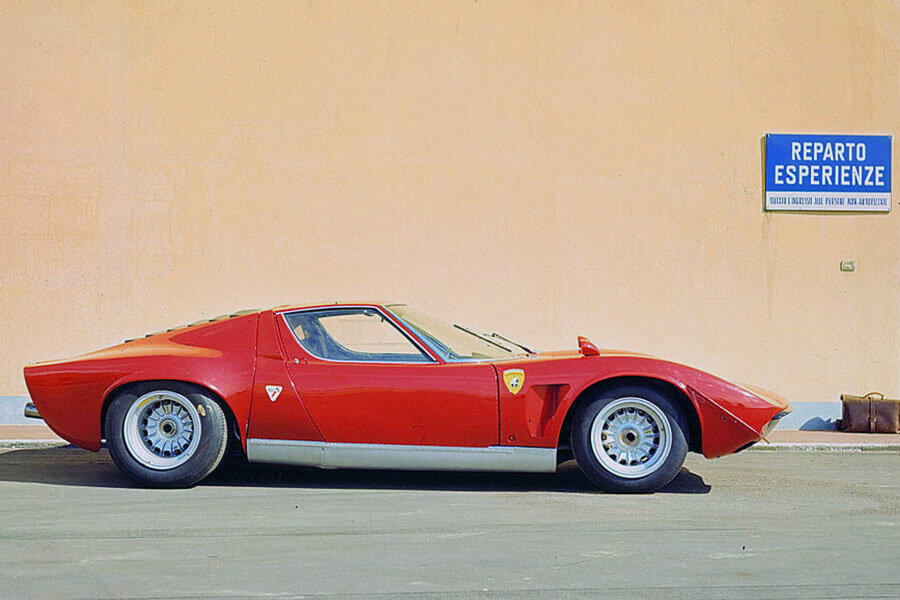Guide: Miura Maxxed - a Historical & Technical Appraisal of the Lamborghini Jota P400
/BACKGROUND
During 1970, Lamborghini development engineer and chief test driver, Bob Wallace, was given the go ahead by general manager, Paolo Stanzani, to construct a mid-engined hot rod more or less from scratch.
Intended to push Lamborghini’s technical boundaries to the limit, the solitary prototype, known as Jota, would officially be used to evaluate the latest suspension, mechanical and aerodynamic ideas.
However, the team working on it also harboured an aspiration to go racing. This was reflected in the new car’s name; ‘Jota’ was a reference to the FIA’s Sporting Code known as the Appendix J regulations.
From 1970, the FIA had two categories for production-based Grand Touring cars: Group 3 and Group 4. For homologation to be granted into either, a minimum number of production cars had to be built during twelve consecutive months.
The Group 3 requirement of 1000 units in a year was well beyond Lamborghini’s reach
Meanwhile, the Group 4 minimum of 500 vehicles theoretically wasn’t too far outside the firm’s capability.
As it transpired though, Miura production never made it beyond half the Group 4 requirement in any given year.
Had the Miura been homologated into the Group 4 Grand Touring category, a car not too dissimilar from the Jota might have cleaned up in the World Sportscar Championship. During 1971, such a vehicle would have been pitched against the Ferrari 365 GTB/4C, Chevrolet Corvette and Porsche 911 ST.
Unfortunately, a combination of Ferruccio Lamborghini’s famous reluctance to go racing, poor trading conditions and the inevitable cost of such a programme ensured the Jota never saw active competition.
Instead, it simply became the most famous of Bob Wallace’s special tuning department hot rods.
CHASSIS
The Jota was built around an uprated Miura chassis (number 5084). The semi-monocoque unit was extensively drilled for lightness and much of the original steel was replaced with a super lightweight aluminium alloy called Avionel.
Sill sections were enlarged so each side could accommodate a 60-litre fuel tank. By contrast, the production Miura used a single tank located underneath the front lid.
Ride-height was dropped by completely reworking the suspension geometry. As usual, suspension was via double wishbones with coil springs, telescopic Koni dampers and anti-roll bars at either end. For the Jota, the dampers and anti-roll bars were made fully adjustable.
The Jota’s stance was further enhanced with Dunlop Racing-shod 15-inch cast-magnesium Campagnolo wheels. These measured 9-inches wide at the front, 12-inches wide at the rear and resulted in dramatically widened track dimensions.
ENGINE / TRANSMISSION
Like all Miura variants, the transversely-mounted Bizzarrini-designed all-alloy DOHC 60° V12 displaced 3929cc thanks to a bore and stroke of 82 and 62mm respectively.
Wallace upped the compression from 10.7:1 to 11.5:1, fitted hot camshafts and four huge triple choke Weber 46 IDL carburettors. Two of the carbs were reversed to lessen fuel surge.
A dry-sump lubrication system was installed pre-dating its arrival on the Miura SV by over a year.
The engine was hooked up to a free-flow competition exhaust with four megaphone outlets.
Peak output jumped to 440bhp at 8500rpm compared to 370bhp at 7700rpm for the standard Miura S.
By way of comparison, the 1230kg Ferrari 365 GTB/4C was rated at 362bhp and Porsche’s 911 2.4 ST produced 250bhp in a circa 840kg package.
Transmission was via Lamborghini’s familiar five-speed gearbox, a triple-plate Borg & Beck competition clutch and limited-slip differential.
BODYWORK
Bodywork was made up from an array of new and modified Miura panels - the doors, engine cover and front lid were all manufactured from Avionel.
The front clamshell featured enlarged radiator ducts and vents, a chin spoiler and large brake cooling vents carved out from behind the wheels.
The retractable headlight mechanisms were removed and fixed units were installed under Plexiglas covers.
Similar covers were also used for the enlarged auxiliary driving lights and indicators.
The rear clam had a flatter fender profile and more pronounced spoiler than standard. Bertone’s distinctive hexagonal tail fascia grille was deleted to allow the four exhausts to exit through the now vacant cavity (as opposed to underneath the bodywork).
Side and rear windows were formed in Plexiglas. The windscreen gained a wiper fixed in an upright position.
The finished car was painted red with silver sills and wheels.
INTERIOR
The Jota’s interior was to full competition specification.
It featured a rudimentary new black metal dash, a roll cage and bucket seats with four-point harnesses.
Other than the black fabric-covered seats, there was no upholstery to speak of and nothing in the way of sound insulation.
WEIGHT / PERFORMANCE
The finished Jota weighed in at just 880kg.
The factory quoted a 197mph top speed and 0-62mph time of under four seconds.
COMPLETION & SUBSEQUENT HISTORY
The Jota was completed in October 1970 and went on to rack up around 20,000km of test mileage.
Chassis 5084 was then sold via the InterAuto dealership in Brescia to Dr. Alfredo Belponer. Belponer was the owner and president of the Scuderia Brescia Corse racing team.
Belponer had agreed to purchase the experimental car after he received a call advising him the fastest Miura ever built was available to add to his collection.
InterAuto received the Jota on April 12th 1971.
However, before Belponer took delivery, chassis 5084 was destroyed when one of the InterAuto mechanics crashed it on the brand new and still unopened Brescia ring road. The Jota barrel rolled into a field and caught fire. Only its engine was salvaged. The rest was scrapped.
By this time, many important customers had seen chassis 5084 around the factory. Although Lamborghini refused to build any additional examples, they did construct a small batch of very special Jota-inspired Miura SV/Js which were later followed by a unique SV/R.
Text copyright: Supercar Nostalgia
Photo copyright: Lamborghini - https://www.lamborghini.com
































